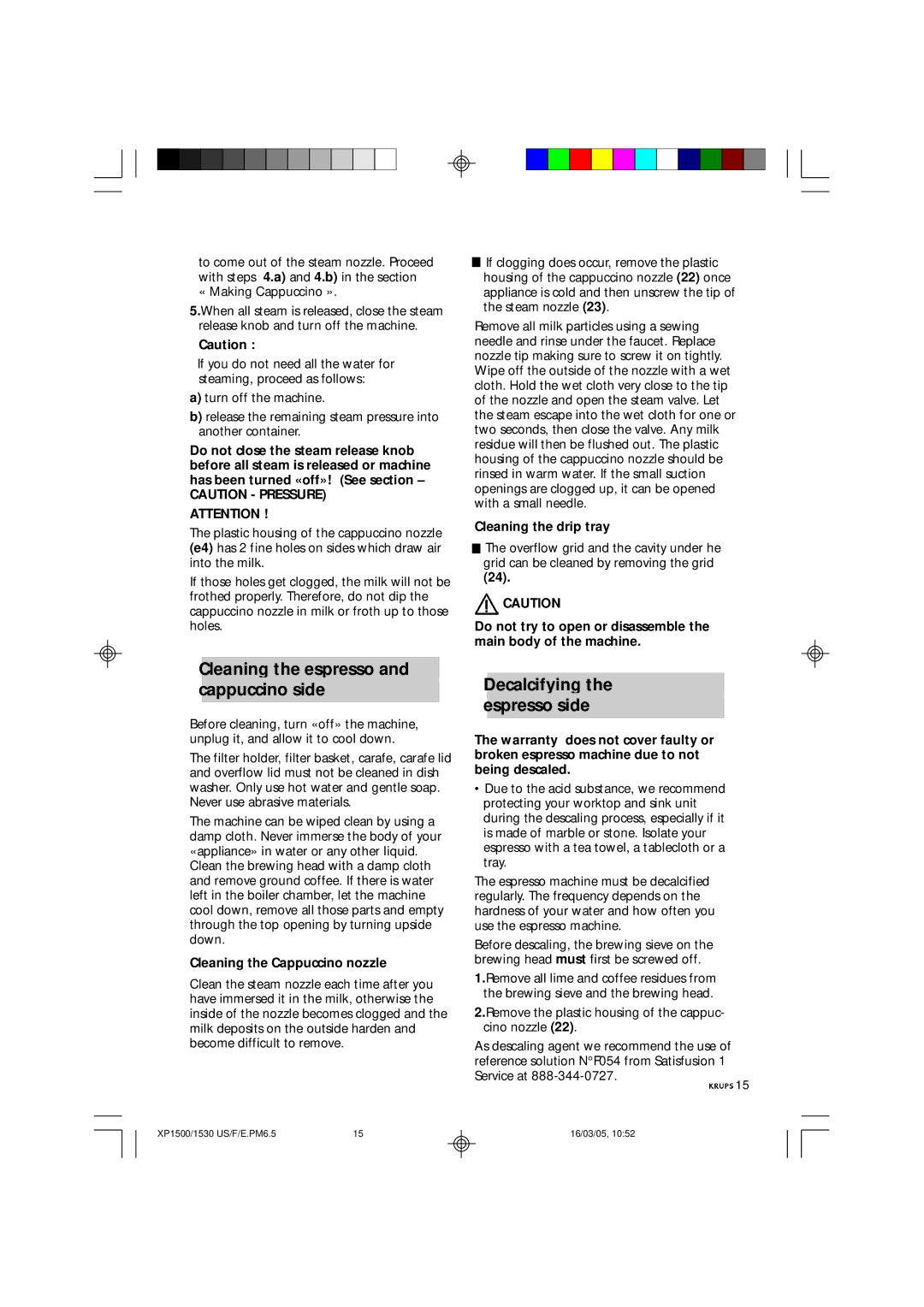
to come out of the steam nozzle. Proceed with steps 4.a) and 4.b) in the section « Making Cappuccino ».
5.When all steam is released, close the steam release knob and turn off the machine.
Caution :
If you do not need all the water for steaming, proceed as follows:
a)turn off the machine.
b)release the remaining steam pressure into another container.
Do not close the steam release knob before all steam is released or machine has been turned «off»! (See section –
CAUTION - PRESSURE)
ATTENTION !
The plastic housing of the cappuccino nozzle (e4) has 2 fine holes on sides which draw air into the milk.
If those holes get clogged, the milk will not be frothed properly. Therefore, do not dip the cappuccino nozzle in milk or froth up to those holes.
![]()
![]() If clogging does occur, remove the plastic housing of the cappuccino nozzle (22) once appliance is cold and then unscrew the tip of the steam nozzle (23).
If clogging does occur, remove the plastic housing of the cappuccino nozzle (22) once appliance is cold and then unscrew the tip of the steam nozzle (23).
Remove all milk particles using a sewing needle and rinse under the faucet. Replace nozzle tip making sure to screw it on tightly. Wipe off the outside of the nozzle with a wet cloth. Hold the wet cloth very close to the tip of the nozzle and open the steam valve. Let the steam escape into the wet cloth for one or two seconds, then close the valve. Any milk residue will then be flushed out. The plastic housing of the cappuccino nozzle should be rinsed in warm water. If the small suction openings are clogged up, it can be opened with a small needle.
Cleaning the drip tray
![]()
![]() The overflow grid and the cavity under he grid can be cleaned by removing the grid
The overflow grid and the cavity under he grid can be cleaned by removing the grid
(24).
CAUTION
Do not try to open or disassemble the main body of the machine.
Cleaning the espresso and
cappuccino side
Before cleaning, turn «off» the machine, unplug it, and allow it to cool down.
The filter holder, filter basket, carafe, carafe lid and overflow lid must not be cleaned in dish washer. Only use hot water and gentle soap. Never use abrasive materials.
The machine can be wiped clean by using a damp cloth. Never immerse the body of your «appliance» in water or any other liquid. Clean the brewing head with a damp cloth and remove ground coffee. If there is water left in the boiler chamber, let the machine cool down, remove all those parts and empty through the top opening by turning upside down.
Cleaning the Cappuccino nozzle
Clean the steam nozzle each time after you have immersed it in the milk, otherwise the inside of the nozzle becomes clogged and the milk deposits on the outside harden and become difficult to remove.
Decalcifying the
espresso side
The warranty does not cover faulty or broken espresso machine due to not being descaled.
•Due to the acid substance, we recommend protecting your worktop and sink unit during the descaling process, especially if it is made of marble or stone. Isolate your espresso with a tea towel, a tablecloth or a tray.
The espresso machine must be decalcified regularly. The frequency depends on the hardness of your water and how often you use the espresso machine.
Before descaling, the brewing sieve on the brewing head must first be screwed off.
1.Remove all lime and coffee residues from the brewing sieve and the brewing head.
2.Remove the plastic housing of the cappuc- cino nozzle (22).
As descaling agent we recommend the use of reference solution N°F054 from Satisfusion 1 Service at
15
XP1500/1530 US/F/E.PM6.5 | 15 |
16/03/05, 10:52
